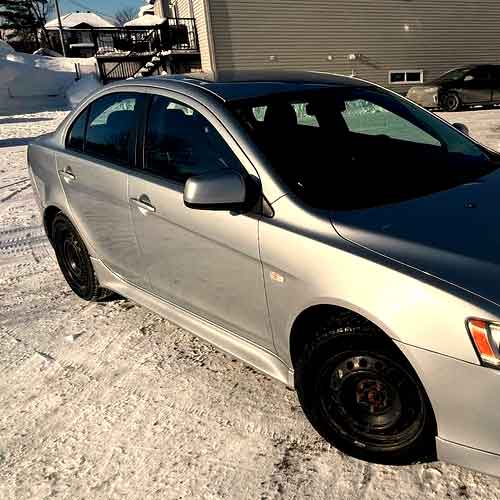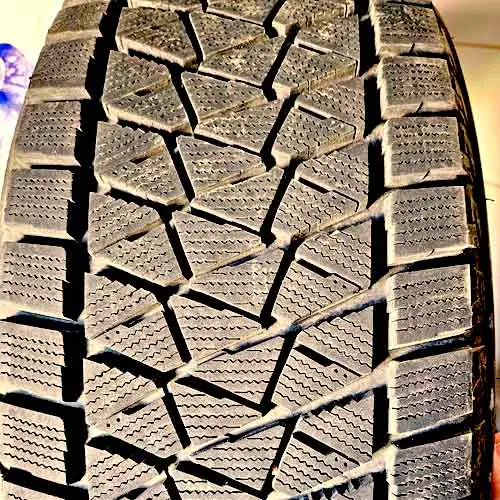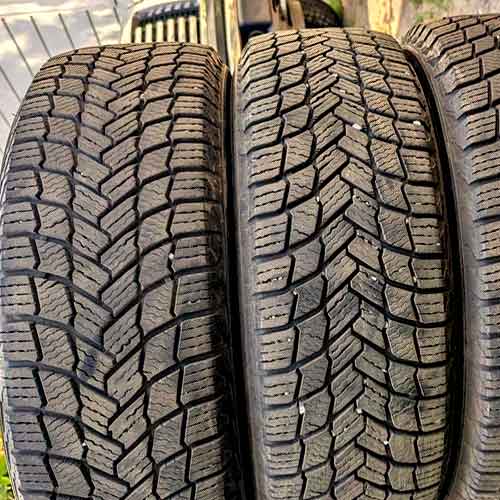The Michelin X Ice Snow and Bridgestone Blizzak DM-V2, both being standout winter tires, excel in different sectors, redefining benchmarks in performance, fuel efficiency, and ride comfort, thereby offering an assortment of solutions to cater to diverse user inclinations and driving situations.

Table of Contents
Available Sizes
The Michelin X-Ice Snow (review) comes in 125 total sizes in 15 to 22 inches. They have following specs.
- Speed ratings: T and H.
- Load ratings: SL and XL.
- Tread depth: 10.5/32″ on all.
- Weight: 16 to 40 lbs.
- Tread warranty: 40k miles.
On the other side, the Bridgestone Blizzak DM-V2 (review) comes in 15 to 22 inches with following.
- Speed ratings: R, S and T.
- Load ratings: SL and XL.
- Tread depth: 13 or 14/32″.
- Weight: 27 to 45 lbs.
- Tread warranty: None.
Tread Pattern
Starting with the Bridgestone Blizzak DM-V2, the tire introduces a uniquely different tread pattern.

The middle area of the tread features three ribs, distinguished from the shoulder lug by broad and noticeable circumferential grooves.
Each of these ribs hosts triangular-shaped blocks, with the central ones exhibiting slightly smoother edges in comparison to their surrounding counterparts.
However, they all sport aggressive wave-like siping, coupled with in-groove notches that intersect with thick rectilinear siping slits.
As we move towards the shoulders, the lugs adopt a blocky form, albeit with off-set edges.
Furthermore, these lugs are separated by wider lateral grooves.
Mirroring the central lugs, the shoulder lugs also incorporate a similar siping pattern.
The Michelin X-Ice Snow, on the other side, stands distinguished with its directional tread pattern.

This tread pattern consists of four circumferential channels, which originate from four central ribs, even though there are six ribs in total when you include the shoulder areas.
Located in the center is the narrowest and most intricate groove, created by two ribs. These ribs support blocks that are festooned with an array of sharp edges, snow vices, chamfered edges, and a blend of interlocking and straight-line siping.
The outer blocks, however, only display wave-like sipes and lack the plethora of biters found in the central blocks.
Finally, the shoulder lugs are the most aggressive part of the design.
They feature the thickest siping, coupled with sharp zigzag teeth on their lateral sides.
Tread Longevity
Tread longevity, heavily impacted by rolling resistance, is a performance dimension, where both tires show up with similar efficacy.
Here the Michelin X Ice Snow has the advantage of weight. It’s lighter structure basically exerts less pressure on its lugs, as the tire rolls, extending its lifespan.
Though its tread life is still similar to its counterpart, which has the advantage of having larger tread depth.
So this tire takes a long time coming down to 2/32″ of legal limit.
Winner: Both!
Ice Performance
In icy conditions, the Michelin X-Ice Snow clearly outshines its competitor. Utilizing advanced design features, such as unique biters scattered across the tread and enhanced with snow vices, the tire is able to deliver slightly better overall traction here.
It’s more innovative design, coupled with multi-angle siping and snow vices, allow for faster braking and handling efficacy on all types of snowy surfaces.
In comparison, the Blizzak DM-V2, despite also possessing multi-angle biters, falls short. Its biters are noticeably wider, which hinders their efficiency on compacted ice where narrower, aggressive siping is required.
Consequently, the DM-V2’s design is better suited for heavier vehicles like SUVs due to its broader tread voids.
Winner: Michelin X Ice Snow.
Wet Traction
Wet traction is largely influenced by two components: the tread design and the rubber compound. These two factors basically tell you about the tire’s ability to clear water away from the sipes and grooves.
Here, the grooves provide majority of water clearing, providing you with primarily, resistance to hydro or aquaplaning.
While sipes, provide you with wet grip, by clearing water off at a micro level. They basically work by sucking water particles in their slits.
Let me discuss these both dimensions in more details below.
Wet Grip
While both tires feature ample siping and flexible tread rubber, the Michelin X Ice claims an edge in terms of wet handling, while both are equal, you can say, when it comes to wet directional grip.
The Michelin X-Ice Snow’s edge in handling can be attributed to its superior water expulsion capabilities from its shoulders, due to the presence of multi-angle sipes and snow vices facing in both lateral and longitudinal directions on the tire’s tread.
These ensure a relatively more effective grip during cornering, avoiding overall slippage.
Conversely, the Bridgestone Blizzak DM-V2’s shoulder sipes are oriented only laterally, resulting in somewhat underwhelming handling performance during testing.
Winner: Michelin X Ice Snow.
Hydroplaning
Hydroplaning, the condition where water prevents the tread from making proper contact with the road, is a significant safety concern.
And the Bridgestone Blizzak DM-V2 outperforms in this area, with its wider grooves effectively dispersing water in all directions.
It’s competitor on the other side, lacking interconnected lugs, restricts water movement, especially laterally, due to its more closed up lugs, positioned longitudinally.
Winner: Bridgestone Blizzak DM-V2.
Snow Performance
When it comes to snow-covered terrains, the Blizzak DM-V2 outperforms nearly all the winter tires out there, including the Michlein X Ice.
This is because the tire features broader grooves, which enhances its ability to make greater snow-to-snow contact, (which is crucial for traction in fluffy snow conditions, as snow sticks better on snow, instead of rubber).
The multiple triangular lugs seen all over the tire’s tread, provide very snow clinging grooves, so you get a better snow holding abilities here, comparatively.
On the other side, the Michelin’s relatively closed pattern struggles to accumulate as much snow, thus hampering its traction.
Winner: Bridgestone Blizzak DM-V2.
Dry Traction
Dry traction, a vital performance measure of any tire, hinges on the extent of rubber in contact with the road surface. In this domain, two key factors come into play: directional grip and lateral traction.
Let me discuss them both separately.
Directional Grip
The efficiency of directional grip primarily depends on the tread’s central region. This is because, while cruising on straight highways, the majority of the tire’s load is concentrated in this area.
The Michelin X-Ice Snow excels here due to its interlocking central lugs, which maximize contact with the road, enabling shorter braking distances, comparatively.
On the other hand, the Blizzak DM V2 falls short in this regard due to its wider grooves and less streamlined structure, showing up with 5 feet longer braking distances.
Winner: Michelin X Ice Snow.
Handling
The quality of tire handling is significantly dictated by the tire’s shoulder design and overall weight. This is because when cornering, the weight load shifts towards the edges of the tread due to inertia.
The Michelin X-Ice Snow again emerges victorious in this aspect, owing to two primary factors. Firstly, its more compact shoulder blocks enhance rubber-to-road contact.
Secondly, the tire’s lighter structure, combined with a shallower tread depth, reduces lug movement (or block bending) during cornering, thus providing balanced understeering and oversteering capabilities.
In contrast, the DM V2, with its wider grooves and larger tread depth, experiences more lug movement during cornering, which diminishes steering feedback.
Winner: Michelin X Ice Snow.
Comfort Levels
The degree of comfort provided by a tire largely hinges on its noise generation and its capability to dampen vibrations. These characteristics are primarily governed by the tire’s construction. Let’s examine each of these elements.
Tread Noise
Tread noise is produced when air particles collide with the tread walls of the tire. In essence, larger tread voids tend to generate more noise.
When comparing the Michelin X-Ice Snow and its counterpart, the former emerges as the quieter option.
This can be attributed to its densely packed shoulder lugs, which serve as the primary entry point for air, as well as its crowded central lug design, offering less room for air particles to move about.
These design attributes not only reduce noise generation at the source but also work in conjunction with the tire’s superior pitch sequencing to further dampen any residual noise.
Winner: Michelin X Ice Snow.
On-Road Vibration
While the Blizzak DM-V2 may generate more noise, it excels in mitigating road vibrations, providing superior impact comfort.
This is due to its more absorbent tread rubber and greater tread depth, which provide a thicker buffer layer between the tire and any road irregularities.
Winner: Bridgestone Blizzak DM-V2.
Summing Up
Under snow-laden conditions, the Bridgestone Blizzak DM-V2 shines owing to its unique tread design and an ample number of tread voids, ensuring superior snow grip and clearance.
However, when traversing icy terrains, the Michelin X-Ice Snow stands out. It utilizes a plethora of intricate biting edges, angled slits, and multi-angled sipes to enhance its overall traction and handling capabilities.
The Michelin X-Ice Snow also demonstrates superior grip on both wet and dry surfaces, although the Bridgestone Blizzak DM-V2 takes the lead in terms of hydroplaning resistance.
After considering all these factors, the Michelin X-Ice Snow edges out slightly ahead due to its enhanced fuel economy, extended tread life, and quieter operation.